В будущее (Russian) ("To the future") | |||||||
| Anthem | "Hymn of a Free Alaska" | ||||||
| Capital | New Archangel | ||||||
| Largest city | Ross | ||||||
| Other cities | New Westminster, Vladikaskady | ||||||
| Language official |
Russian (de facto) | ||||||
| others | English, Spanish, Ukrainian | ||||||
| Religion main |
Eastern Orthodox | ||||||
| others | Catholics, Jews, Protestants | ||||||
| Ethnic Groups main |
Russians and Ukrainians | ||||||
| others | English, Germans, Norwegians | ||||||
| Demonym | Alaskan | ||||||
| Government | Federal presidential republic | ||||||
| Legislature | General Congress | ||||||
| President | Gervasy Johnson (VZ) | ||||||
| Chairman | Diana Feinstein (DMS) | ||||||
| Area | 3,836,094 km² (3,370,724 кв. в.) | ||||||
| Population | 57,314,389 (2007 Census) | ||||||
| Established | March 8, 1917 (Independence) November 27, 1929 (Unification) | ||||||
| Currency | Yefimok (File:Yefimok Symbol (Russian America).svg) (AKY)
| ||||||
| Time Zones | (UTC-8 to -10) | ||||||
| summer | (UTC-7 to -9) | ||||||
| Driving Side | Right | ||||||
| Calling Code | +7 | ||||||
| Internet TLD | .ak, .адфр, .аля | ||||||
| Organizations | NAFTA, NAM, OAS, UN, URSS | ||||||
Alaska (Russian: Аляска, Alyaska), officially known as the Alaskan Democratic Federative Republic (Аляскинская Демократическая Федеративная Республика, Alyaskinskaya Demokraticheskaya Federativnaya Respublika), and commonly abbreviated as the ADFR (АДФР); is a sovereign state located along the Northwest Coast region of North America. The nation is a federation comprised of 18 governorates which are bordered by Borealia and the United States to the east, Mexico to the south, and the Russian Federation west of the Bering Strait.
The territory of modern day Alaska was initially an integral part of the Russian Empire (with the territory being acquired from Spain and the United Kingdom). Russian America developed throughout the 19th Century as an invaluable region of the empire, due in no small feat to the numerous gold rushes within the region. By the turn of the century and the subsequent collapse of the Russian Empire, Alaska became an independent nation. Following a decade of instability and war, an American-styled liberal democracy was established. Alaska would play a key role during the Cold War as a buffer state between the two Superpowers.
Alaska is unique in that it's both the only nation in the New World to have an Eastern Orthodox majority and the only nation outside the former Soviet Union to have a Russian-speaking majority. Much like its neighbors across the Americas, Alaska is a nation of immigrants. Those of Russian, Ukrainian, English, Norwegian, German, and Chinese descent currently make up the biggest demographics within the nation.
Etymology
The name Alaska is derived from the Aleut idiom алахсхаӄ (alaxsxaq), which figuratively referred to the mainland (as opposed to the Catherine Archipelago). The word literally translates as "the object to which the action of the sea is directed." The Aleut name was translated into Russian as Аляска (Alyaska). Though the name was originally used solely for the peninsula of the same name, the Russians gradually adopted the word as a colloquial/poetic name for all of Russia's North American territory.
History
- Main articles: History of Alaska and Timeline
Russian Expansion
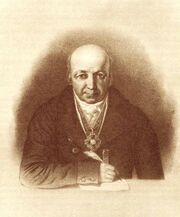
Governor Alexander Baranov.
Under the leadership of Alexander Andreyevich Baranov throughout the early 1800s, the Russian Empire began to solidify their power within the Pacific Northwest of North America by means of exploration and expansion. Their most ambitious goal of expanding into the Californias was achieved in 1812 when Ivan Kuskov (under the support of Baranov) established a base of operations along the Slavianka River (Fortress Ross). Early enthusiasm by both Baranov and Kuskov helped to encourage further settlement in the region. While most early settlers were initially fur traders and employees of the Russian-American Company, it would soon become populated by settlers from the agricultural regions of the Russian Empire (including criminals and exiles).
The growing Russian presence brought inevitable tensions with Spain (who held initial claims to the territory). Russians justified their claims on the grounds that they were well north of Spain's northernmost port (San Francisco) and that no other Europeans settlements had been established prior to the Russians. With the ongoing wars of independence across Latin America, Spanish ships were ordered to remove the Russian settlers from the region. Despite hopes of a simple operation, Aleut fishermen spotted the ships approaching and alerted the colony. The subsequent battle ended with the colonists able to defend Fort Ross and forced the Spanish ships to retreat. Once the word reached Saint Petersburg about the unprovoked attack by Spain, the Russian Empire declared war.
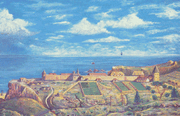
Fortress Ross (circa 1828).
The war between Russia and Spain would continue for another three years, with most of the fighting taking place in Alta California. The conflict soon turned in favor of the Russians as Mexico established an alliance with the Russian Empire (both sides wanting the Spanish out). The Treaty of Saint Petersburg marked the formal end to the fighting in 1825. The treaty stipulated Spain was to relinquish its claims to the Pacific Northwest over to Russia. Mexico voluntarily gave up any claims to the Ross Colony, and years later would agreed to sell additional territory. Along with the Napoleonic Wars and the Finnish War, the Russo-Spanish War further established the Russian Empire as a great power.
Relations with the United Kingdom and the United States became mixed throughout the early 19th Century. The USA reluctantly abandoned their goals of expanding to the Pacific Ocean and would soon look elsewhere. Following the Texas Revolution, Russia became a mediator between Mexico and the US in resolving the situation peacefully. But following the Canadian Revolution and new tensions with the United Kingdom, the Russian Empire began to organize its territories in North America. The governing of the colonies were removed from the Russian-American Company and Russian America was organized into three integral oblasts: Alaska (Pavlovskaia), New Russia (New Archangel), and Oregon (Ross).
Gold Rushes
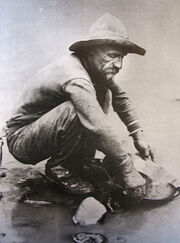
Gold prospector in Sonoma.
The discovery of gold in 1848 effectively changed the region as people from around the world rushed to the region to get rich. The influx of new settlers into the region prompted the Russian Empire to establish the Sonoma Oblast in 1850. The once minor settlement of Ross quickly grew into a major city on the Pacific Ocean. Other settlements would arise within the region; including Vladikaskady, Kuskovsk, Shasta, and Zavalishino.
The wave of immigration also helped to push infrastructural projects within the region. Among the most noted was the construction of the Russian-American Telegraph line, which was also proposed as an alternative to the many failed Transatlantic Telegraph Cables at the time. Construction on the joint Russian-American-British project began in 1865, with the project being a symbolic failure after the announcement of a successful transatlantic line in 1867. Despite the setbacks, the project continued as an Imperial connection, with the project being completed in 1872. The subsequent monetary problems within the British colonies in the area prompted them to sell the colonies to the Russian Empire in 1872.
Additional projects were the construction of the first transcontinental railroad in the 1880s and the railway system connection Ross and the northernmost settlements for the first time. The new inter-connectivity helped further populate the north (as access to raw materials was easier for stable living). Once minor fishing and fur trading settlements like Nikolayevsk-Amerikansky, Nooshagak, and Slavorossiysk began to industrialize themselves in order to sell their products more quickly with the southern settlements and beyond.

The northern portions of Russian America would expand further following the discovery of several gold mines across the Yukon River region by the turn of the century. A new wave of immigration and infrastructural expansion began across Russian America. The use of railroads helped to keep the region active, but most still relied heavily on sled dogs to keep connection between the gold regions and the railroad hubs farther south.
Independence
Throughout its existence, the colonists of Russian America had viewed their isolation from the Russian Empire as both a blessing and a curse. It was during this time that a separate Alaskan identity had developed and calls for greater autonomy began to become louder. Such movements only became more pronounced in the early 20th Century as Alaska's place within the globe became more active. This became apparent during the Russo-Japanese War, where Russian Americans bore the brunt of the fighting against Japan (becoming Alaska's first major war since the Russo-Spanish War a century before). Despite their victory in the war, a series of rebellions broke out across the Empire (among the rebels included Alaskans). Tsar Nicholas II would reluctantly agree to give Russian America more autonomy, though hopes of establishing a commonwealth were quickly ignored. Under the reforms, Russian America was allowed to have a democratic legislature (the state duma), though the Tsar retained the power to dissolve the body at will (which took place following the first election).
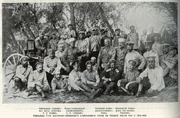
Alaskan troops in Manchuria.
It was only during the chaos of World War I that independence became a reality. The Alaskan Republic was declared on March 8, 1917. Despite several failed efforts to recapture their colonies, the monarchy was overthrown in November the same year (leading to the collapse of the Russian Empire). The new Communist government of Russia, led by Vladimir Lenin, formally recognized Alaska's independence. Ironically, the collapse of the Russian Empire only brought more conflict within Alaska. The influx of White Émigrés quickly conflicted with the original settlers.
The internal fighting resulted in the breakup of the Alaskan Republic, resulting in decades of war. The south was dominated by liberal democracies, among them including the Doug-controlled nation of Columbia (which sought to be either reincorporated into the British Empire or gain statehood in the United States). The northern nations were much more radical, with continued fighting between the [now] White-controlled Alaskan Republic (headed by Nicholas the Younger) and the communist Alaskan Socialist Republic. Fighting between the Reds and the Whites came to a halt following the death of Nicholas the Younger in 1929 and the subsequent coup d'état which brought a fully democratic government into power.
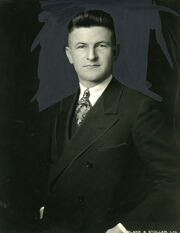
President Mikhail Luchkovich.
Under the leadership of Mikhail Luchkovich, the newly democratized Alaskan Republic began talks to reunite Alaska as a single nation. Unification talks were accelerated following the Wall Street Crash of 1929 and culminated into the temporary "Krakh Constitution" weeks later between the Alaskan Republic and the Oregonian Republic. A formal constitution was adopted in 1931, at which point Luchkovich was elected as the nation's first president. Commonwealth of Columbia and the Sonoman People's Republic rejoined Alaska in 1934 and 1935 (respectively). The administrations of Luchkovich and his successor, Taras Ferley, established an uneasy truce with the Alaskan Socialist Republic (which Luchkovich hoped would peacefully be reunited with Alaska). Following the German invasion of the Soviet Union in 1941, conflict resumed with the ASR. The Communist government quickly collapse following the capture of Nooshagak in 1942, resulting the complete reunification of Alaska. A new constitution was adopted following the election of Dmitry Yakimishchak in 1945.
Government and Politics

President Gervasy Johnson.
The Alaskan Democratic Federative Republic is a federation and a presidential republic. The President of Alaska is elected every six-years using an electoral college (one of the few nations to use this process of selecting a leader), where electors are democratically elected by the citizens of the nation. The president is elected to serve a single six-year term in office, being barred from ever holding the office following their tenure. The current President is the former governor of the Far North, Gervasy Johnson, who was elected on July 28, 2015.
The General Congress is the bicameral legislature of Alaska, comprised of the Senate (upper house) and the State Duma (lower house). Each governorate is entitled to five senators each within the Senate, while deputies of the State Duma are tallied based on the population of each governorate. Both chambers are headed by a Chairman, who is elected among their peers. Diana Feinstein is the current Chairman of the Senate, while Ivan Kantor is the current Chairman of the State Duma. Because Alaska does not have a vice presidency, the Chairman of the Senate is second in line in the event the President of Alaska can no longer serve the office.
Alaskan politics are currently dominated by two political parties: the center-right Evergreens and the center-left Movement for Peace and Freedom. A third political party, the Doug minority Civil Alliance, currently plays a minor role in both chambers of the General Congress and local elections.
Administrative Divisions

The governorates of Alaska.
The Alaskan Democratic Federative Republic is a federation comprised of 18 governorates (Russian: губернии, gubernii; singular: губерния, guberniya). Under the constitution, each governorate is a sovereign entity which retain control over internal affairs, yet are united under a unified nation. The national capita, New Archangel is an independent city within the governorate of Sitka.
Most of the contemporary governorates were established throughout the 20th Century to allow for more regional governments. The most recent to gain "governoratehood" was the Far North in 1994 (prior to which it was an incorporated territory). Alaska is also one of the few nations to have claimed territory in Antarctica. Known as Alexander Land, this territory was inherited from the Russian Empire and is overlapped by competing claims by Argentina, Chile, Russia (which claims the exact same strip of land), and the United Kingdom.
Demographics
Ethnography
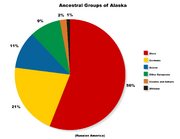
A pie chart showing largest ancestral groups of Alaska.
As with many of the nations of the Western Hemisphere, Alaska is a country of immigrants. The majority of Alaskans can trace their ancestries back to the various ethnic groups of the Russian Empire, with East Slavs being dominant. Those of Ukrainian descent currently make up the largest single group within Alaska, followed closely by those of Russian descent. Other prominent Slavic groups include: Belarusians, Bulgarians, Croats, Macedonians, Poles, and Serbs. Those of Finnish and Karelian descent currently form the largest non-Slavic group to have immigrated from the Russian Empire. Other such prominent groups include: Armenians, Estonians, Georgians, Latvians, Lithuanians, and Manchus. Due to the predominance of the Eastern Orthodox Church within Alaska, the many Orthodox immigrants to the New World often chose to settle in Alaska over other areas. These groups include: Amharas, Assyrians, Copts, Greeks, Romanians, and Tigrays.
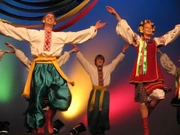
A group of Ukrainian Alaskan dancers in traditional dress.
Central Alaska (most notably within Columbia) are populated mostly by those of English and Scottish descent. Many can trace their ancestry back to the original British settlers to the region during the early 19th Century. Despite the area being sold to Russia in 1872, many of the British settlers remained in the area and developed in a distinctive group of people known as the Dougs (which currently make up a fourth of Alaska's population). It was during the latter half of the 19th Century that Danes, Norwegians, and Swedes began to immigrate to Alaska, settling mostly within New Russia (which has often been compared to Scandinavia). Germans also chose to settle across Alaska, which also included many Volga Germans. Though not as numerous, Americans and Mexicans have also settled within Alaska (mostly along the border of their respective countries).
Asians currently make up the largest non-European group within Alaska, with those of Han Chinese descent making up the largest single group. Other prominent peoples of this group include: Filipinos, Japanese, Koreans, and Vietnamese. A small number of Africans have settled in Alaska, with most tracing their ancestry back to escaped and freed slaves from the United States. Despite the mostly immigrant population, Native Alaskans currently make up roughly one-twentieth of the population (with most non-native Alaskans having some traces of native ancestry). Currently, Aleuts and Inuits make up the largest groups.
Languages
The Alaskan Democratic Federative Republic does not recognize any official language on the federal level. For all intense and purposes, the Russian language is the predominant national language. As of the 2007 Census, the vast majority of Alaskans were either native or fluent speakers of Russian. As a member of the Russophone, Alaska also holds a unique position as the only nation in the Western Hemisphere to use the Cyrillic alphabet. The Alaskan dialects of Russian, while mutually intelligible to speakers of Standard Russian, have been heavily influenced by other languages in the region (such as Aleut, English, and Spanish) and from immigrant groups (such as Chinese, Greek, and Ukrainian).
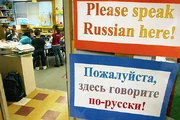
A message in both English and Russian, stating that the Russian language is the preferred means of communication at said location.
The second most-spoken language in Alaska is English, with a majority of Alaskans have some understanding of the language. Historically, English was the administrative language of the British colonies of Columbia, the Queen Charlotte Islands, and Vancouver Island; and would remain so for decades following the Columbia Purchase in 1872. Early attempts to Russify the area have been mixed, yet the English language remained dominate in this area up until the 1940s. Since then, English has sharply declined as the first language of these areas (being replaced by Russian). In contrast, the overall use of English as a second language has been increasing, due especially to Alaska's relations with the United States.
Other prominent languages spoken in Alaska include: Armenian, Chinese, Finnish, German, Greek, Hindustani, Japanese, Korean, Manchu, Norwegian, Polish, Punjabi, Spanish, Swedish, Tagalog, Ukrainian, Vietnamese, Yiddish, and Yugoslav (to name a few). Among the Alaskan Indians, Aleut remains the most-spoken. Haida, Inuit, Pomo, Tlingit, and Yupik are also spoken by their respective communities.
Religion
According to the constitution, Alaska is a secular state which promotes the separation of church and state and secures the rights and securities of all religious practices within the nation. Culturally and demographically, Alaska is a Christian dominated nation, with all major denominations being worshiped. The Eastern Orthodox Church is the single largest organization, making Alaska the only Orthodox majority country in the Americas. Eastern Orthodoxy was first introduced during the 18th Century by the expanding Russian Empire. As part of the empire, Russian America would be controlled by the Russian Orthodox Church. The church would play a key role in the development of Russian America until their independence in 1917. Today, all Alaskan lands are under the control of the autocephalous Orthodox Church in Alaska (OCA). Unlike their colonial predecessor, the OCA also incorporates Bulgarian, Georgian, Greek, and Serbian traditions (among others).
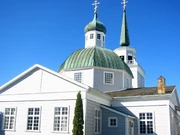
Protestants make up the second-largest Christian group in Alaska and hold dominance in the central, Northern European-dominated governorates. American and British traders were the first to introduce Protestantism to the Pacific Northwest. Later immigration from the Baltic States, Finland, and Scandinavia would help cement these churches within Russian America and contemporary Alaska. The three-largest denominations (in order) are Pentecostals, Lutherans, and Baptists. Outside of Protestantism, Anglicans and Spiritual Christians (Molokans and Doukhobors) are also prominent.
Catholics currently make up the third-largest Christian group. Unlike their continental neighbors, most Alaskan Catholics belong to the Greek Catholic Church. Greek Catholicism was first introduced by Ukrainian immigrants during the early 20th Century. The Church of Jesus Christ of Latter-day Saints is the fourth-largest Christian group and is prominent along the border with Borealia.
Jews currently make up the largest non-Christian group in Alaska. Most Alaskan Jews emigrated from the Western Russian Empire (Poland and Ukraine) after World War II. Buddhists, Hindus, Taoists, Muslims, Animists, and Shamanists dominate much of the non-Christian and non-Jewish population. According to the 2007 Census, roughly a fifth of Alaskans describe themselves as being either spiritual but not religious, irreligious, agnostic, and/or atheist. Template:RA-Alaska



